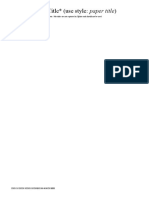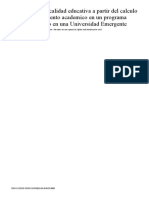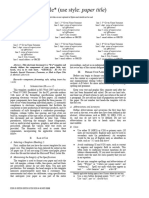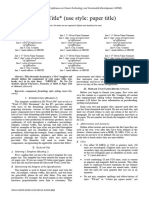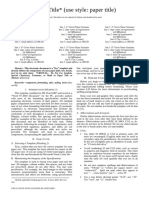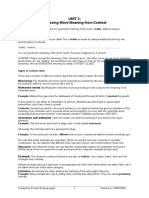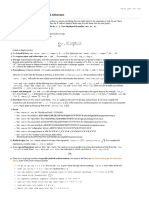0 ratings0% found this document useful (0 votes)
50 viewsPaper de Energías Renovables
Paper de Energías Renovables
Uploaded by
Carlos JavierDando a conocer conceptos respecto a las energías renovables; energía eólica energía mareomotriz y energía térmica. Con formato de la ieee
Copyright:
© All Rights Reserved
Available Formats
Download as DOC, PDF, TXT or read online from Scribd
Paper de Energías Renovables
Paper de Energías Renovables
Uploaded by
Carlos Javier0 ratings0% found this document useful (0 votes)
50 views12 pagesDando a conocer conceptos respecto a las energías renovables; energía eólica energía mareomotriz y energía térmica. Con formato de la ieee
Original Title
Paper de energías renovables
Copyright
© © All Rights Reserved
Available Formats
DOC, PDF, TXT or read online from Scribd
Share this document
Did you find this document useful?
Is this content inappropriate?
Dando a conocer conceptos respecto a las energías renovables; energía eólica energía mareomotriz y energía térmica. Con formato de la ieee
Copyright:
© All Rights Reserved
Available Formats
Download as DOC, PDF, TXT or read online from Scribd
Download as doc, pdf, or txt
0 ratings0% found this document useful (0 votes)
50 views12 pagesPaper de Energías Renovables
Paper de Energías Renovables
Uploaded by
Carlos JavierDando a conocer conceptos respecto a las energías renovables; energía eólica energía mareomotriz y energía térmica. Con formato de la ieee
Copyright:
© All Rights Reserved
Available Formats
Download as DOC, PDF, TXT or read online from Scribd
Download as doc, pdf, or txt
You are on page 1of 12
Paper Title* (use style: paper title) FORMATO
*Note: Sub-titles are not captured in Xplore and should not be used
XXX-X-XXXX-XXXX-X/XX/$XX.00 ©20XX IEEE
line 1: 1st Given Name Surname
line 1: 2nd Given Name Surname line 1: 3rd Given Name Surname
line 2: dept. name of organization
line 2: dept. name of organization line 2: dept. name of organization
(of Affiliation)
(of Affiliation) (of Affiliation)
line 3: name of organization
line 3: name of organization line 3: name of organization
(of Affiliation)
(of Affiliation) (of Affiliation)
line 4: City, Country
line 4: City, Country line 4: City, Country
line 5: email address
line 5: email address line 5: email address
line 1: 4th Given Name Surname
line 1: 5th Given Name Surname line 1: 6th Given Name Surname
line 2: dept. name of organization
line 2: dept. name of organization line 2: dept. name of organization
(of Affiliation)
(of Affiliation) (of Affiliation)
line 3: name of organization
line 3: name of organization line 3: name of organization
(of Affiliation)
(of Affiliation) (of Affiliation)
line 4: City, Country
line 4: City, Country line 4: City, Country
line 5: email address
line 5: email address line 5: email address
Abstract—This electronic document is a “live” template and and rms do not have to be defined. Do not use abbreviations
already defines the components of your paper [title, text, heads, in the title or heads unless they are unavoidable.
etc.] in its style sheet. *CRITICAL: Do Not Use Symbols,
Special Characters, Footnotes, or Math in Paper Title or B. Units
Abstract. (Abstract)
Use either SI (MKS) or CGS as primary units. (SI
Keywords—component, formatting, style, styling, insert (key units are encouraged.) English units may be used as
words) secondary units (in parentheses). An exception would
be the use of English units as identifiers in trade, such
I. INTRODUCTION (HEADING 1) as “3.5-inch disk drive”.
This template, modified in MS Word 2007 and saved as a Avoid combining SI and CGS units, such as current
“Word 97-2003 Document” for the PC, provides authors in amperes and magnetic field in oersteds. This often
with most of the formatting specifications needed for leads to confusion because equations do not balance
preparing electronic versions of their papers. All standard dimensionally. If you must use mixed units, clearly
paper components have been specified for three reasons: (1) state the units for each quantity that you use in an
ease of use when formatting individual papers, (2) automatic equation.
compliance to electronic requirements that facilitate the Do not mix complete spellings and abbreviations of
concurrent or later production of electronic products, and (3)
units: “Wb/m2” or “webers per square meter”, not
conformity of style throughout a conference proceedings.
“webers/m2”. Spell out units when they appear in
Margins, column widths, line spacing, and type styles are
text: “. . . a few henries”, not “. . . a few H”.
built-in; examples of the type styles are provided throughout
this document and are identified in italic type, within Use a zero before decimal points: “0.25”, not “.25”.
parentheses, following the example. Some components, such Use “cm3”, not “cc”. (bullet list)
as multi-leveled equations, graphics, and tables are not
prescribed, although the various table text styles are C. Equations
provided. The formatter will need to create these
The equations are an exception to the prescribed
components, incorporating the applicable criteria that follow.
specifications of this template. You will need to determine
whether or not your equation should be typed using either the
II. EASE OF USE Times New Roman or the Symbol font (please no other font).
To create multileveled equations, it may be necessary to treat
A. Selecting a Template (Heading 2) the equation as a graphic and insert it into the text after your
First, confirm that you have the correct template for your paper is styled.
paper size. This template has been tailored for output on the
Number equations consecutively. Equation numbers,
A4 paper size. If you are using US letter-sized paper, please
within parentheses, are to position flush right, as in (1), using
close this file and download the Microsoft Word, Letter file.
a right tab stop. To make your equations more compact, you
may use the solidus ( / ), the exp function, or appropriate
B. Maintaining the Integrity of the Specifications exponents. Italicize Roman symbols for quantities and
The template is used to format your paper and style the variables, but not Greek symbols. Use a long dash rather than
text. All margins, column widths, line spaces, and text fonts a hyphen for a minus sign. Punctuate equations with commas
are prescribed; please do not alter them. You may note or periods when they are part of a sentence, as in:
peculiarities. For example, the head margin in this template
measures proportionately more than is customary. This
measurement and others are deliberate, using specifications ab
that anticipate your paper as one part of the entire
proceedings, and not as an independent document. Please do Note that the equation is centered using a center tab stop.
not revise any of the current designations. Be sure that the symbols in your equation have been defined
before or immediately following the equation. Use “(1)”, not
“Eq. (1)” or “equation (1)”, except at the beginning of a
III. PREPARE YOUR PAPER BEFORE STYLING
sentence: “Equation (1) is . . .”
Before you begin to format your paper, first write and
save the content as a separate text file. Complete all content D. Some Common Mistakes
and organizational editing before formatting. Please note
sections A-D below for more information on proofreading, The word “data” is plural, not singular.
spelling and grammar. The subscript for the permeability of vacuum 0, and
Keep your text and graphic files separate until after the other common scientific constants, is zero with
text has been formatted and styled. Do not use hard tabs, and subscript formatting, not a lowercase letter “o”.
limit use of hard returns to only one return at the end of a In American English, commas, semicolons, periods,
paragraph. Do not add any kind of pagination anywhere in question and exclamation marks are located within
the paper. Do not number text heads-the template will do that quotation marks only when a complete thought or
for you. name is cited, such as a title or full quotation. When
quotation marks are used, instead of a bold or italic
A. Abbreviations and Acronyms typeface, to highlight a word or phrase, punctuation
should appear outside of the quotation marks. A
Identify applicable funding agency here. If none, delete this text box.
parenthetical phrase or statement at the end of a
Define abbreviations and acronyms the first time they are
sentence is punctuated outside of the closing
used in the text, even after they have been defined in the
abstract. Abbreviations such as IEEE, SI, MKS, CGS, sc, dc,
parenthesis (like this). (A parenthetical sentence is B. Identify the Headings
punctuated within the parentheses.) Headings, or heads, are organizational devices that guide
A graph within a graph is an “inset”, not an “insert”. the reader through your paper. There are two types:
The word alternatively is preferred to the word component heads and text heads.
“alternately” (unless you really mean something that Component heads identify the different components of
alternates). your paper and are not topically subordinate to each other.
Do not use the word “essentially” to mean Examples include Acknowledgments and References and, for
“approximately” or “effectively”. these, the correct style to use is “Heading 5”. Use “figure
caption” for your Figure captions, and “table head” for your
In your paper title, if the words “that uses” can table title. Run-in heads, such as “Abstract”, will require you
accurately replace the word “using”, capitalize the to apply a style (in this case, italic) in addition to the style
“u”; if not, keep using lower-cased. provided by the drop down menu to differentiate the head
from the text.
Be aware of the different meanings of the
homophones “affect” and “effect”, “complement” and Text heads organize the topics on a relational,
“compliment”, “discreet” and “discrete”, “principal” hierarchical basis. For example, the paper title is the primary
and “principle”. text head because all subsequent material relates and
elaborates on this one topic. If there are two or more sub-
Do not confuse “imply” and “infer”. topics, the next level head (uppercase Roman numerals)
The prefix “non” is not a word; it should be joined to should be used and, conversely, if there are not at least two
the word it modifies, usually without a hyphen. sub-topics, then no subheads should be introduced. Styles
named “Heading 1”, “Heading 2”, “Heading 3”, and
There is no period after the “et” in the Latin “Heading 4” are prescribed.
abbreviation “et al.”.
The abbreviation “i.e.” means “that is”, and the C. Figures and Tables
abbreviation “e.g.” means “for example”. a) Positioning Figures and Tables: Place figures and
An excellent style manual for science writers is [7]. tables at the top and bottom of columns. Avoid placing them
in the middle of columns. Large figures and tables may span
across both columns. Figure captions should be below the
IV. USING THE TEMPLATE
figures; table heads should appear above the tables. Insert
After the text edit has been completed, the paper is ready figures and tables after they are cited in the text. Use the
for the template. Duplicate the template file by using the abbreviation “Fig. 1”, even at the beginning of a sentence.
Save As command, and use the naming convention
prescribed by your conference for the name of your paper. In TABLE I. TABLE TYPE STYLES
this newly created file, highlight all of the contents and
import your prepared text file. You are now ready to style Table Table Column Head
your paper; use the scroll down window on the left of the MS Head Table column subhead Subhead Subhead
Word Formatting toolbar. copy More table copya
a. Sample of a Table footnote. (Table footnote)
A. Authors and Affiliations
The template is designed for, but not limited to, six Fig. 1. Example of a figure caption. (figure caption)
authors. A minimum of one author is required for all
Figure Labels: Use 8 point Times New Roman for Figure
conference articles. Author names should be listed starting
labels. Use words rather than symbols or abbreviations when
from left to right and then moving down to the next line. This
writing Figure axis labels to avoid confusing the reader. As
is the author sequence that will be used in future citations
an example, write the quantity “Magnetization”, or
and by indexing services. Names should not be listed in
“Magnetization, M”, not just “M”. If including units in the
columns nor group by affiliation. Please keep your
label, present them within parentheses. Do not label axes
affiliations as succinct as possible (for example, do not
only with units. In the example, write “Magnetization (A/m)”
differentiate among departments of the same organization).
or “Magnetization {A[m(1)]}”, not just “A/m”. Do not label
1) For papers with more than six authors: Add author axes with a ratio of quantities and units. For example, write
names horizontally, moving to a third row if needed for “Temperature (K)”, not “Temperature/K”.
more than 8 authors.
2) For papers with less than six authors: To change the ACKNOWLEDGMENT (Heading 5)
default, adjust the template as follows. The preferred spelling of the word “acknowledgment” in
a) Selection: Highlight all author and affiliation lines. America is without an “e” after the “g”. Avoid the stilted
expression “one of us (R. B. G.) thanks ...”. Instead, try “R.
b) Change number of columns: Select the Columns
B. G. thanks...”. Put sponsor acknowledgments in the
icon from the MS Word Standard toolbar and then select the
unnumbered footnote on the first page.
correct number of columns from the selection palette.
c) Deletion: Delete the author and affiliation lines for REFERENCES
the extra authors.
The template will number citations consecutively within
brackets [1]. The sentence punctuation follows the bracket
[2]. Refer simply to the reference number, as in [3]—do not
use “Ref. [3]” or “reference [3]” except at the beginning of a
sentence: “Reference [3] was the first ...”
Number footnotes separately in superscripts. Place the [2] J. Clerk Maxwell, A Treatise on Electricity and Magnetism, 3rd ed.,
actual footnote at the bottom of the column in which it was vol. 2. Oxford: Clarendon, 1892, pp.68–73.
cited. Do not put footnotes in the abstract or reference list. [3] I. S. Jacobs and C. P. Bean, “Fine particles, thin films and exchange
anisotropy,” in Magnetism, vol. III, G. T. Rado and H. Suhl, Eds. New
Use letters for table footnotes. York: Academic, 1963, pp. 271–350.
Unless there are six authors or more give all authors’ [4] K. Elissa, “Title of paper if known,” unpublished.
names; do not use “et al.”. Papers that have not been [5] R. Nicole, “Title of paper with only first word capitalized,” J. Name
published, even if they have been submitted for publication, Stand. Abbrev., in press.
should be cited as “unpublished” [4]. Papers that have been [6] Y. Yorozu, M. Hirano, K. Oka, and Y. Tagawa, “Electron spectroscopy
studies on magneto-optical media and plastic substrate interface,”
accepted for publication should be cited as “in press” [5]. IEEE Transl. J. Magn. Japan, vol. 2, pp. 740–741, August 1987
Capitalize only the first word in a paper title, except for [Digests 9th Annual Conf. Magnetics Japan, p. 301, 1982].
proper nouns and element symbols. [7] M. Young, The Technical Writer’s Handbook. Mill Valley, CA:
University Science, 1989.
For papers published in translation journals, please give
the English citation first, followed by the original foreign-
language citation [6]. IEEE conference templates contain guidance text for
composing and formatting conference papers. Please
ensure that all template text is removed from your
[1] G. Eason, B. Noble, and I. N. Sneddon, “On certain integrals of conference paper prior to submission to the
Lipschitz-Hankel type involving products of Bessel functions,” Phil. conference. Failure to remove template text from
Trans. Roy. Soc. London, vol. A247, pp. 529–551, April 1955. your paper may result in your paper not being
(references) published.
We suggest that you use a text box to insert a graphic
(which is ideally a 300 dpi TIFF or EPS file, with all fonts
embedded) because, in an MSW document, this method is
somewhat more stable than directly inserting a picture.
To have non-visible rules on your frame, use the
MSWord “Format” pull-down menu, select Text Box >
Colors and Lines to choose No Fill and No Line.
XXX-X-XXXX-XXXX-X/XX/$XX.00 ©20XX IEEE
Conferencia
Suministros de energia limpia y de calidad
Javier Meza Carlos Elihu
dept. redaccion cientifica y academica
Universidad Continental
Huancayo, Peru
AVANCE
76478376@continental.edu.pe
Abstract—This electronic document is a
B. Potencia eolica instalada en el mundo
V. INTRODUCTION
A nivel mundial, en el año 2012 la potencia eólica instalada
Ante esta realidad dominada por fuentes fósiles (petróleo y es de 282.482 MW. China fue líder mundial en potencia
gas) como principales energías primarias, unas prevenciones eólica instalada acumulada, con 75.564 MW (26,8% del
imparables de crecimiento de la demanda energética total mundial), seguida de Estados Unidos con 60.007 MW
derivado de un elevado crecimiento económico y un interés (21,2%), Alemania con 31.332 MW (11,1%), España con
marcado en la lucha contra el cambio climático, se hace 22.796 MW (8,1%) e India con 18.421 MW (6,5%)[13].
imprescindible trabajar en el uso eficiente de la energía y la
diversificación de la oferta energética (fuentes renovables),
entre otros asuntos. [8].
VIII. ENERGIA SOLAR
El año 2012 el 75% del suministro de energía primaria en el
A. Viabilidad de la energia solar termoelectrica en
mundo se deriva de los combustibles fósiles, 11% de España
biomasa, un 7.2% de energía hidroeléctrica, un 5.5% de
En la mayor parte de la zona de clima mediterráneo
energía nuclear y solo el 0.4% de la energía solar, eólica y
la energía recibida por el suelo en un día supera, por término
geotérmica. [9].
medio, los 4,25 kWh/m2. [14].
La búsqueda de una matriz energética sostenible se ha
constituido en los últimos años como una prioridad de B. Suministrar soluciones de energia limpia a Africa.
política energética por su contribución a afrontar los retos de África tiene gracias a sus recursos naturales una gran fuente
la seguridad energética, la mejora de la competitividad de la de energíarenovable del sol, y la energía solar es segura,
economía y el cambio climático. confiable y su costo es bajo, por ello es una alternativa ideal
para los países cuya generación de electricidad es
La energía renovable tiene muchos tipos de energía solar y insuficiente.
cada una cubre una necesidad, la más completa son las
placas fotovoltaicas ya que producen electricidad y esta se
IX. CENTRALES DE MAREOMOTRIZ
puede utilizar para cualquier consumo; pero las hay
específicas para calefacción, agua caliente, calentar piscinas, A. Energia Mareomotriz: Potencial Energetico
sacar agua de un pozo, etc. [10]. Los mares y océanos tienen gran potencial energético, con
posibilidades de ser convertido en electricidad,cuarta parte
En el trabajo presente se realizará un trabajo de del mercado de la energía marina. [15].
investigación descriptivo para la comparación y análisis de
los diferentes medios de generación de energía renovables B. Primera planta comercial de energia mareomotriz
a nivel mundial por construir en el rompeolas de
como la energía térmica, energía eólica, energía hidráulica y
Mutriku.
energía mareomotriz para así poder obtener resultados de
Una apertura en medio del rompeolas permite al mar
diversos medios la cual se puede obtener energía limpia y de
elevarse y descender de ntro de una cámara como resultado
calidad, además, favorables para la sociedad en la cual
de la acción de las olas. Este movimiento comprime y
encontramos.
descomprime el volumen de aire contenido en la misma. Por
VI. CENTRALES HIDROELECTRICAS tanto la energía generada por la diferencia de presión es
transformada en electricidad[16].
A. El % de consumo de las mini hidroelectricas
Aprovechaban las corrientes de agua para mover los
molinos que transformaban la energía mecánica en energía ACKNOWLEDGMENT
eléctrica. Hoy, cerca de 7% de toda la energía en EE.UU.
es hidráulica.En América Latina, en cambio, la The preferred spelling of the word “acknowledgment” in
hidroeléctrica es la mayor fuente de energía, representando America is without an “e” after the “g”. Avoid the stilted
expression “one of us (R. B. G.) thanks ...”. Instead, try “R.
cerca de 65% del total de la energía generada. [11]. B. G. thanks...”. Put sponsor acknowledgments in the
unnumbered footnote on the first page.
VII. CENTRALES EOLICAS
A. Carbon versus viento REFERENCES
El costo medio de generar con carbón, que incluye
[8] BUSCH, P.-O.; JÒRGENS, H. (2012). Europeanization through
externalidades ambientales por 1 7dólares/MWh, es de 78 diffusion? Renewable energy policies and alternative sources for
dólares/MWh. El costo medio de generar con viento es European convergence. En: MORATA y SOLORIO SANDOVAL
considerablemente mayor, 1 36 dólares/Mwh. [12].
(eds.). European Energy Policy: An Environmental Approach, [13] Borja-Díaz M (1999) A. Estado del arte y tendencias de la tecnología
Cheltenham, UK: Edward Elgar, 66-82. eoloeléctrica. 1^sup a^ ed. Cap. 4. Instituto de Investigaciones
[9] FREIER, A. (2016b). Integración energética regional en Mercosur. Eléctricas. UNAM. México. www.iie.org.mx/EnoC/eolico22// libroo/
Los casos de Argentina y Brasil en el área de la energía renovable. En: liro.htm.
GUZOWSKI (comp.). Políticas de promoción de las Energías [14] BRAKMANN, G. y RAINER, A (2004): Energía solar termoeléctrica.
Renovables. Experiencias en América del Sur. Bahía Blanca: Ediuns, 2020 pasos firmes contra el cambio climático, Greenpeace,
153-192. Amsterdam.
[10] SORDA, G., BANSE, M., KEMFERT, C., “An overview of biofuel [15] Gómez, L. y Burgos, W. 2008. Actualización del Inventario de
policies across the world”, Energy Policy, vol. 38, pp. 6977-6988, Posibilidades de Generación de Energía Mareomotriz en Colombia.
Nov.2010. Trabajo para optar al título de Ingeniero Electricista. Universidad de
[11] Cavalcante MM, Santos LJ. Hidrelétricas no Rio Madeira-RO: la Salle, Facultad de Ingeniería Eléctrica. Bogotá, Colombia.
tensões sobre o uso do território e dos recursos naturais na Amazônia. [16] https://search.proquest.com/docview/447265387?accountid=146219
Confins. Revue franco-brésilienne de géographie/Revista franco-
brasilera de geografia. 2012 Jun 23(15)
[12] Giumelli, L. (2008), presentación en el 10° Congreso Técnico
Internacional, Buenos Aires, 7 de noviembre.
You might also like
- Dwnload Full Starting Out With Java From Control Structures Through Objects 7th Edition Gaddis Test Bank PDFDocument36 pagesDwnload Full Starting Out With Java From Control Structures Through Objects 7th Edition Gaddis Test Bank PDFimperialwarrayur16o100% (16)
- Honda cbr600rr 07-09 Parts CatalogueDocument274 pagesHonda cbr600rr 07-09 Parts CatalogueOscar Aguilar UgaldeNo ratings yet
- Business Writing Workbook PDFDocument79 pagesBusiness Writing Workbook PDFAdam Diaz100% (18)
- Cambridge Reading Skills AnswersDocument108 pagesCambridge Reading Skills AnswersNguyễn Tuấn Định100% (4)
- Conference Template A4Document6 pagesConference Template A4Alex QuilleNo ratings yet
- ISMoHIM Template A4 NewDocument6 pagesISMoHIM Template A4 Newarief imanNo ratings yet
- A New Approach of Under-Frequency Load SDocument6 pagesA New Approach of Under-Frequency Load SRevit Mep Khoa Đ-đtspktNo ratings yet
- Simulation of MSU-IIT Electrical Power System Using Fuse-to-Fuse Selective CoordinationDocument6 pagesSimulation of MSU-IIT Electrical Power System Using Fuse-to-Fuse Selective CoordinationMAcryan Pacquiao PactolNo ratings yet
- Conference Template A4Document6 pagesConference Template A4anon_197725243No ratings yet
- Paper Title: XXX-X-XXXX-XXXX-X/XX/$XX.00 ©20XX IEEEDocument6 pagesPaper Title: XXX-X-XXXX-XXXX-X/XX/$XX.00 ©20XX IEEEanks202No ratings yet
- Template IOMA 2019Document6 pagesTemplate IOMA 2019Vlăduțu Iuliana GeorgianaNo ratings yet
- Optimizing Handovers (Intra/Inter Frequency) in LTE Using SON (Self Organized Network) SystemDocument6 pagesOptimizing Handovers (Intra/Inter Frequency) in LTE Using SON (Self Organized Network) SystemRahul KrishnanNo ratings yet
- Mediciòn de La Calidad Educativa A Partir Del Calculo Del Rendimiento Academico en Un Programa Universitario en Una Universidad EmergenteDocument6 pagesMediciòn de La Calidad Educativa A Partir Del Calculo Del Rendimiento Academico en Un Programa Universitario en Una Universidad EmergenteRICRA CHAUCA YORDIN KENEDYNo ratings yet
- Research Paper GuideDocument6 pagesResearch Paper GuideDhan Alhen Rainier AsuncionNo ratings yet
- Pengaruh Jumlah Uang Saku Mahasiswa UMN Terhadap Pengeluaran (Use Style: Paper Title)Document6 pagesPengaruh Jumlah Uang Saku Mahasiswa UMN Terhadap Pengeluaran (Use Style: Paper Title)Yustinus LionardyNo ratings yet
- Conference Template LetterDocument5 pagesConference Template LetterErick ItasNo ratings yet
- 2017 05 MSW Usltr FormatDocument5 pages2017 05 MSW Usltr FormatMaria MoldovanNo ratings yet
- Paper Title (Use Style: Paper Title)Document3 pagesPaper Title (Use Style: Paper Title)Juan Felipe Ocampo RamirezNo ratings yet
- Conference Template A4Document6 pagesConference Template A4Kedir WarituNo ratings yet
- Icmr 2021 TemplateDocument3 pagesIcmr 2021 TemplateFery SeftiawanNo ratings yet
- IEEE - Conference Template A4Document3 pagesIEEE - Conference Template A4dejeme8956No ratings yet
- Paper Title (Use Style: Paper Title)Document3 pagesPaper Title (Use Style: Paper Title)farah paramitaNo ratings yet
- Conference PaperDocument3 pagesConference PaperSwati EkhandeNo ratings yet
- Paper Title (Use Style: Paper Title)Document3 pagesPaper Title (Use Style: Paper Title)Diego CarhuapumaNo ratings yet
- Knowledge and Attitudes Towards People With Dementia Among General Population in YogyakartaDocument3 pagesKnowledge and Attitudes Towards People With Dementia Among General Population in YogyakartaFebri ArifNo ratings yet
- Conference Template A4Document3 pagesConference Template A4chalfouhayoub1No ratings yet
- Paper Title (Use Style: Paper Title)Document3 pagesPaper Title (Use Style: Paper Title)Md Inam Ullah KhanNo ratings yet
- Paper Title (Use Style: Paper Title)Document4 pagesPaper Title (Use Style: Paper Title)Ricardo QuiñonesNo ratings yet
- Conference Template A4Document3 pagesConference Template A4Anggi PerwitasariNo ratings yet
- Paper Title (Use Style: Paper Title)Document3 pagesPaper Title (Use Style: Paper Title)SUNDARAMAHALINGAM ANo ratings yet
- Paper Title (Use Style: Paper Title) : Note: Sub-Titles Are Not Captured in Xplore and Should Not Be UsedDocument5 pagesPaper Title (Use Style: Paper Title) : Note: Sub-Titles Are Not Captured in Xplore and Should Not Be Used八島諒汰No ratings yet
- Research Paper TemplateDocument3 pagesResearch Paper Templatehadi rahmandaNo ratings yet
- Conference English TemplateDocument3 pagesConference English Templatenavid kamravaNo ratings yet
- EditedDocument5 pagesEditedamirulkuetNo ratings yet
- Conference Template UpdatedDocument3 pagesConference Template UpdatedChoco MeowMeowNo ratings yet
- Paper Title (Use Style: Paper Title)Document3 pagesPaper Title (Use Style: Paper Title)Tarun gNo ratings yet
- Wa0021.Document3 pagesWa0021.rakshana kalidasNo ratings yet
- Paper Title (Use Style: Paper Title)Document5 pagesPaper Title (Use Style: Paper Title)Gauthier Djiemeni ToudjeuNo ratings yet
- Paper Title (Use Style: Paper Title)Document3 pagesPaper Title (Use Style: Paper Title)DeadNo ratings yet
- Paper Title (Use Style: Paper Title)Document3 pagesPaper Title (Use Style: Paper Title)Ryan ReasNo ratings yet
- ICDSIS 2024 Conference TemplateDocument3 pagesICDSIS 2024 Conference TemplateAvni DwivediNo ratings yet
- Ieee - Ciees2024 Template A4Document3 pagesIeee - Ciees2024 Template A4Vahid HelacNo ratings yet
- Paper Title (Use Style: Paper Title)Document3 pagesPaper Title (Use Style: Paper Title)Julio Cesar Estrella PanezNo ratings yet
- Camera Ready PaperDocument3 pagesCamera Ready PaperjimiteshchowdaryNo ratings yet
- Conference Template A4Document3 pagesConference Template A4Catur NugrohoNo ratings yet
- CRATE-2024 Paper FormatDocument3 pagesCRATE-2024 Paper Formatlilleshkanchi1310No ratings yet
- Paper Title (Use Style: Paper Title) : Note: Sub-Titles Are Not Captured in Xplore and Should Not Be UsedDocument6 pagesPaper Title (Use Style: Paper Title) : Note: Sub-Titles Are Not Captured in Xplore and Should Not Be UsedAvinash ShindeNo ratings yet
- Paper Title (Use Style: Paper Title) : 1) A. Abbreviations and AcronymsDocument3 pagesPaper Title (Use Style: Paper Title) : 1) A. Abbreviations and AcronymsSaidur Rahman SidNo ratings yet
- Paper Title (Use Style: Paper Title) : Note: Sub-Titles Are Not Captured in Xplore and Should Not Be UsedDocument6 pagesPaper Title (Use Style: Paper Title) : Note: Sub-Titles Are Not Captured in Xplore and Should Not Be UsedjavedNo ratings yet
- Paper Title (Use Style: Paper Title)Document3 pagesPaper Title (Use Style: Paper Title)Amol Ramesh LendalNo ratings yet
- Early Plant Disease Detection Using AIDocument5 pagesEarly Plant Disease Detection Using AIPraveen J LNo ratings yet
- Template JournalDocument3 pagesTemplate Journalwensdb118No ratings yet
- Conference TemplateDocument5 pagesConference TemplateaggdribsrdmsecNo ratings yet
- Paper Title (Use Style: Paper Title) : 2021 1st International Conference On Power Electronics and Energy (ICPEE-2021)Document3 pagesPaper Title (Use Style: Paper Title) : 2021 1st International Conference On Power Electronics and Energy (ICPEE-2021)gopalchandramahatoNo ratings yet
- IEEE Xplore Conference-template-A4Document3 pagesIEEE Xplore Conference-template-A4bmeNo ratings yet
- IEEE Conference Template (A4)Document3 pagesIEEE Conference Template (A4)MeeTh0D4No ratings yet
- Conference Template A4Document3 pagesConference Template A4Vishnu PriyaNo ratings yet
- ITC India 2023 Conference-Template-A4Document3 pagesITC India 2023 Conference-Template-A4Compiler Design - Dr. BRBNo ratings yet
- Template Conferences IEEEDocument5 pagesTemplate Conferences IEEESantiago CastañoNo ratings yet
- Conference Template LetterDocument3 pagesConference Template LetterAnass CherrafiNo ratings yet
- Advance Computer Programming: NotesDocument4 pagesAdvance Computer Programming: NotesGlyza Marie Sederio ButronNo ratings yet
- JTEHM TemplateDocument6 pagesJTEHM TemplateKalaimani ThirugnanamNo ratings yet
- Learn RebolDocument465 pagesLearn Rebolsquatty100% (1)
- Iq SQL ComandosDocument508 pagesIq SQL ComandosmanuNo ratings yet
- Mckinsey CV WorkshopDocument21 pagesMckinsey CV Workshopapi-25973897No ratings yet
- Purdue Owl - Apa StyleDocument53 pagesPurdue Owl - Apa StylemuhammadhanifmohdfahmiNo ratings yet
- Unit 2-Guessing MeaningDocument6 pagesUnit 2-Guessing MeaningPorntip Bodeepongse รักในหลวงNo ratings yet
- FEM TemplateDocument3 pagesFEM Templatehuashen caoNo ratings yet
- Basic Numeracy SimplificationDocument6 pagesBasic Numeracy SimplificationIAS EXAM PORTALNo ratings yet
- CB190R 2.0Document157 pagesCB190R 2.0wz8t82gn8bNo ratings yet
- 90203-1104DEB - Operation Manual (E Series) PDFDocument404 pages90203-1104DEB - Operation Manual (E Series) PDFKamilNo ratings yet
- In Text Citations - PPTXPDFDocument25 pagesIn Text Citations - PPTXPDFNUR AMMIERA BINTI ZOLKEFLINo ratings yet
- Dylan Reference ManualDocument448 pagesDylan Reference Manualpablo_marxNo ratings yet
- MathJax Basic Tutorial and Quick Reference - Mathematics Meta Stack ExchangeDocument19 pagesMathJax Basic Tutorial and Quick Reference - Mathematics Meta Stack ExchangenctrungvlNo ratings yet
- Optimizing CDocument189 pagesOptimizing CJuan LambertNo ratings yet
- 3HAC16580-1 Revf enDocument232 pages3HAC16580-1 Revf enSusheel ShuklaNo ratings yet
- Periodic Table of The ASCII CharactersDocument2 pagesPeriodic Table of The ASCII CharactersKarlNo ratings yet
- Forti Recorder Handbook RevisionDocument225 pagesForti Recorder Handbook RevisioneffahpaulNo ratings yet
- Integrating Textual Evidence in Lit PapersDocument2 pagesIntegrating Textual Evidence in Lit PapersOsman YavascaNo ratings yet
- Math Jax Tutorial (Math Stack Exchange)Document68 pagesMath Jax Tutorial (Math Stack Exchange)nihar.sarkar1975No ratings yet
- CH 1 PreliminariesDocument9 pagesCH 1 Preliminariesalimomo12mNo ratings yet
- Punctuation MarksDocument1 pagePunctuation MarksJiddery VilleNo ratings yet
- Punctuation MarksDocument7 pagesPunctuation Marksmarkosmark575No ratings yet
- 38 NCMC All DocsDocument19 pages38 NCMC All DocsBinod SahuNo ratings yet
- Module 2 - Language of SetsDocument13 pagesModule 2 - Language of SetsNick GamingNo ratings yet
- Order of Operations MdasDocument25 pagesOrder of Operations Mdasapi-258749062No ratings yet




